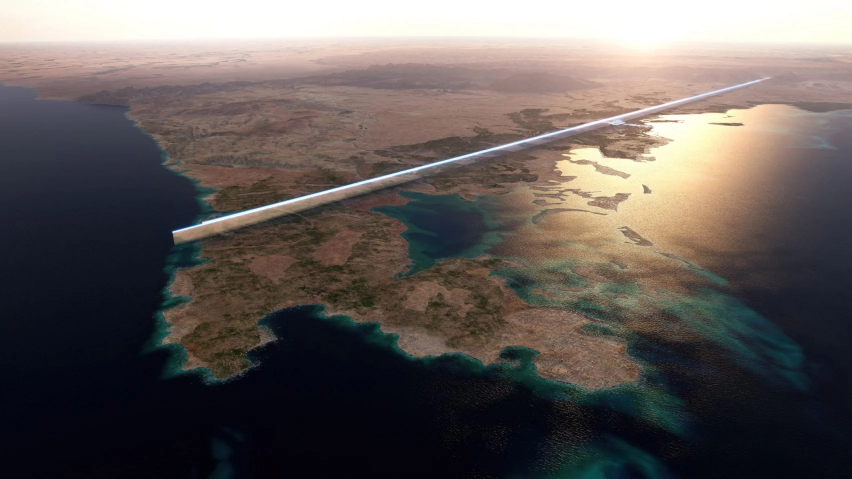
Researchers propose Saudis turn The Line into The Circle to improve mobility
Complexity Science Hub Vienna researchers Rafael Prieto-Curiel and Daniel Kondor have calculated the mobility issues that The Line linear city in Saudi Arabia is likely to experience.
In a piece titled Arguments for building The Circle and not The Line in Saudi Arabia published in journal NPJ Urban Sustainability, Prieto-Curiel and Kondor argued that a line was an inefficient shape for a city.
"We should seriously consider whether the truly unique attribute of The Line – its form – is the best shape for a new city," wrote the duo.
"In The Line, people are as far away from others as possible"
In the piece, Prieto-Curiel and Kondor aimed to analyse the transport implications of The Line, which is planned as a city for nine million people that would consist of two parallel 170-kilometre-long skyscrapers.
"We note that there are other possible reasons for choosing this unique form, such as the creation of a unique identity that will create and reinforce a status of global city for The Line," wrote Prieto-Curiel and Kondor.
"However, it is important to understand the impact of this choice on sustainability outcomes, especially if The Line is expected to have a global impact as a showcase of modern construction and city planning technologies."
The authors calculated the average distances between people, commuting times and transport network for the city based on existing information on The Line.
"One of the most critical aspects related to The Line is distance," wrote the authors. "If its nine million inhabitants are homogeneously distributed in the city, each kilometre will have roughly 53,000 people. If we randomly pick two people from the city, they will be, on average, 57 kilometres apart."
"Keeping the surface fixed, a line is the contiguous urban form that maximises the distance between its inhabitants," they continued. "In The Line, people are as far away from others as possible."
"Active mobility is not viable in The Line since distances are too long"
According to the authors, the large distances will greatly reduce "active mobility" within the proposed city.
"Considering that a walkable distance is one kilometre, in The Line, only 1.2 per cent of the population is at walking distance from others," they wrote.
"Active mobility is not viable in The Line since distances are too long. The plan for The Line has no cars but also gets rid of most active mobility."
The authors accepted that there are "positive aspects" of the planned city, including its car-free nature, focus on high-speed railway for transportation and small footprint due to its form. However, they highlighted several potential flaws in the plans.
"Travelling between two locations in The Line will take an hour on average"
Prieto-Curiel and Kondor calculate that the city will need 86 train stations "to guarantee that everyone is within walking distance of a station". And the required stopping time at the stations would reduce the speed of trips.
"With so many stations, trains stop too frequently, reducing their average speed and spending too much time at stations," they said.
"Travelling from one random location of The Line to the other will take, on average, at least 60 minutes, including walking to and from a station, waiting for the next service and riding a train that frequently stops."
The duo calculated that with 86 train stations people would need to walk 18 minutes on average to a station, but increasing or reducing this number would increase overall travel times.
They concluded that "the population of The Line will experience higher commuting times than much bigger cities, such as Seoul".
"A round urban form is the most desirable"
In response to The Line's form, Prieto-Curiel and Kondor suggested that a circle may be a more efficient shape for a city.
They calculated that taking The Line's skyscrapers and arranging them in a circle, in a city they dubbed The Circle, would dramatically reduce commuting distances.
"The Circle occupies roughly the same surface as Pisa, Italy, but has 50 times its population," they said.
"A round urban form is the most desirable since it reduces commuting distances and the energy required for transport."
The duo also calculated that turning The Line into The Circle would reduce average distances between people and allow people to walk and cycle more.
"A circle that occupies the same surface as The Line has a radius of only 3.3 kilometres," they said.
"In The Circle, the expected distance between two random people is only 2.9 kilometres. In The Circle, a person is at a walking distance of 24 per cent of the population (and within two kilometres, they could reach 66 per cent of the destinations), so most of their mobility could be active."
The Line is planned as one of 10 regions within the wider Neom development in northwest Saudi Arabia. The project, which is one of the largest and most controversial in the world, has been criticised on sustainability grounds and due to its human rights impact.
We recently published a guide to the development, which explains the project and why it is controversial.
It has been criticised for its human rights record, with ALQST reporting that three members of the Huwaitat tribe, who are believed to have criticised displacements connected to Neom, have been sentenced to death.
In October, human rights organisation ALQST reported that three men forcibly evicted from the site of the project had been sentenced to death.
Earlier this year, the UN Human Rights Council expressed alarm over the imminent executions.